| Latest | Greatest | Lobby | Journals | Search | Options | Help | Login |
|
|
|
This topic is archived. |
| Home » Discuss » Topic Forums » Sports |
|
| Jack Rabbit
|
Sat Mar-27-10 10:44 PM Original message |
| The JR Chess Report (March 27): Magnus, Chuckie win Amber RB; Vasily Smyslov dies |
|
Chuckie, Magnus joint winners in Nice
 Ukranian grandmaster Vassily Ivanchuk, who clebrated his 41st birthday during the event, and 19-year Norwegian GM Magnus Carlsen, the world's top ranked player, are the co-wiiners of the 19th annual Melody Amber Rapid/Blindfold Tournament in the French Mediterranean city of Nice. The pair also tied for first in the rapid competition ahead of Russians Vladimir Kramnik and Sergey Karjakin; the pair finished tied for second in the blindfold competition behind Alexander Grischuck, who replaced the indisposed Alexander Morozevich less than a week before the start of the tournament. Grischuk, however, finished with a minus score in the rapid competition and finished fourth overall. Kramnik finished third in the combined totals. Magnus won a total of 13 games out of 22 played while "Chuckie," as Ivanchuk is called by his numerous fans, won only seven games. However, Ivanchuk went undefeated while Magnus dropped six games, including both his games against Ivanchuk on the opening day of tourrnament. 19th Melody Amber Rapid/Blind Tournament Final Standings . . . . . . . . . . . .---- Blindfold ---- ---- Rapid ----- .Total -------- . . . . . . . . . . . . . .+ . - . =. . . . .+ . - . = . . .Points -----SB- Vassily Ivanchuk. . . . . .2 . 0 . 9. . . . .5 . 0 . 6 . . . . 14� . . 158� Magnus Carlsen. . . . . . .6 . 4 . 1. . . . .7 . 2 . 2 . . . . 14� . . 142� Vladimir Kramnik. . . . . .5 . 3 . 3. . . . 5 . 3 . 3 . . . . 13. . . 137� Alexander Grischuk. . . . .6 . 1 . 4. . . . .2 . 4 . 5 . . . . 12� . . 123� Sergey Karjakin . . . . . .4 . 4 . 3. . . . .4 . 2 . 5 . . . . 12. . . 120� Vugar Gashimov. . . . . . .2 . 2 . 7. . . . .3 . 2 . 5 . . . . 11� . . 120� Boris Gelfand . . . . . . .3 . 2 . 6. . . . .4 . 4 . 3 . . . . 11� . . 116� Peter Svidler . . . . . . .3 . 3 . 5. . . . .4 . 3 . 4 . . . . 11� . . 115� Levon Aronian . . . . . . .4 . 5 . 2. . . . .4 . 3 . 4 . . . . 11. . . 108� Ruslan Ponomariov . . . . .2 . 4 . 5. . . . .3 . 5 . 3 . . . . .9. . . .92� Jan Smeets. . . . . . . . .1 . 4 . 6. . . . .1 . 8 . 2 . . . . .6. . . .61� Leinier Dom�nguez . . . . .0 . 6 . 5. . . . .0 . 6 . 5 . . . . .5. . . .57� Former World Champion Vasily Smyslov Dies 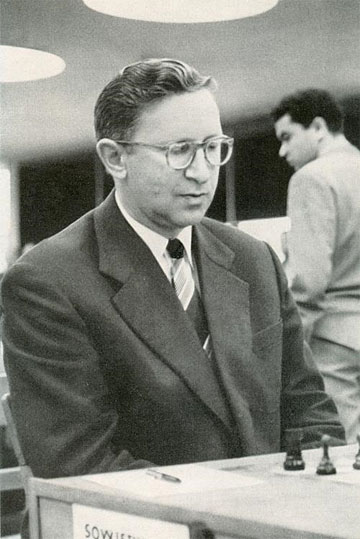 1921 - 2010 Vasily Smyslov, one of the greatest chess masters of the twentieth century and the seventh world champion of chess, passed away early Saturday morning in a Moscow hospital of a heart ailment only three days after his 89th birthday. Smyslov was one of two "winter world champions" to reign during the era of Soviet hegenomy in chess, the other being the late Mikhail Tal. The "winter champions" took the title away form Mikhail Botvinnik, Smyslov in 1957 and Tal in 1960, only to lose it back to Botvinnik in a re-match following a one-year reign. Smyslov also drew a title match against Botvinnik in 1954, with the title reverting to Botvinnik as the incumbant champion. In 1948, Smyslov competed in the World Championship Tournament in The Hague and Moscow, which was played to determine a successor to Dr. Alexander Alekhine, who died in 1946 while holding the title. In that event, Smyslov, the relatively unheralded player of the tournament, finished second to Botvinnik. Smyslov was an established player by 1941, when at the age of 20 he took part in a tournament for the title of abolute champion of the Soviet Union. Nevertheless, his first love was singing opera and he decided on a career in chess only after failing an audition for the Bolshoi Opera Company. After losing the title to Botvinnik in 1958, Smyslov remained one of the world's strongest players for many years and often participated in the world championship cycle. In 1983, at the age of 62, he qualified for the round of candidates' matches, becoming the oldest person ever to do so. He fought well and reached the final match, where he was defeated by Garry Kasparov. Smyslov played chess until 2001, when worsening eyesight forced him to retire at the age of 80. Calendar Philadelphia Open 31 March-4 April. This replaces the Foxwoods Open after the Foxwoods Resort announced expected room rate hikes. Russian Team Championships, Dagomys 1-12 April. Bundesliga 0910, Rounds 14-15 (season finale), Erfurt, Eppingen, Bremen, Baden Baden. 10-11 April. Women's Grand Prix, Nalchik 23 April-6 May. Anand-Topalov Match for the World Title, Sofia 23 April-10 May. Bosna 2010, Sarajevo 5-14 May. Grand Prix, Astrakhan (Russia) 9-25 May. US Championship, St. Louis 13-25 May. Chicago Open 27-31 May. Women's Grand Prix, Jermuk 23 June-6 July. World Open, Valley Forge, Pennsylvania 29 June-5 July. Women's Grand Prix, Ulan Bator (Mongolia) 29 July-12 August. World Junior Championships, Chotowa Czarna (Poland) 2-17 August. Chess Olympiad, Khanty Mansiysk 19 September-4 October. European Club Cup, Plovdiv 16-24 October. Women's Grand Prix, Vina del Mar (Chile) 27 October-9 November. World Youth Championships, Halidiki (Greece) 19-31 October. FIDE Women's Knock Out (Women's World Championship), Turkey 2-25 December. |
| Printer Friendly | Permalink | | Top |
| Jack Rabbit
|
Sat Mar-27-10 10:48 PM Response to Original message |
| 1. This week's games |
|
Your humble hare acknowledges the assistance of Fritz 6.0 on analysis. Diagrams on the Jack Rabbit Chess Report are made with Chess M�rida, a true type font that can be downloaded free here. !""""""""# $tMvWlVmT% $OoOoOoOo% $ + + + +% $+ + + + % $ + + + +% $+ + + + % $pPpPpPpP% $RnBqKbNr% /(((((((() WHITE White to move (This position is a theoretical draw) I would like to thank my impressive and loyal staff: Buccaneer, Spitfire, Swashbuckler, Pancho and Robin Hood. |
| Printer Friendly | Permalink | | Top |
| Jack Rabbit
|
Sat Mar-27-10 10:50 PM Response to Reply #1 |
| 2. 19th Melody Amber Rapid/Blindford Tournament, Nice |
 Nice: Night View with Blurred Cars |
| Printer Friendly | Permalink | | Top |
| Jack Rabbit
|
Sat Mar-27-10 10:50 PM Response to Reply #2 |
| 3. Aronian - Ivanchuk, Rapid Competition, Round 4 |
|
Edited on Sat Mar-27-10 10:53 PM by Jack Rabbit
 Vassily Ivanchuk Levon Aronian - Vassily Ivanchuk 19th Melody Amber Tounament (Rapid Competition), Round 4 Nice, 16 March 2010 English Game: Romanishin Gambit 1.Nf3 Nf6 2.c4 e6 3.g3 a6
4.Bg2 b5 5.b3 Bb7
6.Nc3
6...b4 7.Na4 d6
8.d4 Nbd7 9.a3
9...a5 10.0-0 c5 11.Bb2
11...Qc7!?
12.Re1
12...Be4 13.Bh3 Be7 14.Ng5
14...Bg6 15.axb4 h6 16.Nxe6 fxe6 17.bxc5!?
17...dxc5! 18.Bxe6 cxd4 19.Qxd4
19...Nc5 20.Qe3
20...Nxe6 21.Bxf6 Bxf6!?
!""""""""# $t+ +l+ T% $+ W + O % $ + +mVvO% $O + + + % $n+p+ + +% $+p+ Q P % $ + +pP P% $R + R K % /(((((((() WHITE: Levon Aronian Position after 21...Be7f6:B 22.Qxe6+!
22...Qe7 23.Qc6+ Kf7 24.Qd5+
24...Qe6 25.Qb7+ Be7 26.Nc5!?
26...Qf5!
27.Nd7!?
!""""""""# $t+ + + T% $+q+nVlO % $ + + +vO% $O + +w+ % $ +p+ + +% $+p+ + O % $ + +oO O% $R + R K % /(((((((() WHITE: Levon Aronian Position after 27.Nc5d7 27...Rhd8!
28.Rad1 Qe4 29.Rd5
29...Kg8 30.Qb6 Kh7 31.h4?
31...Bxh4!?
32.Rd4?
32...Qf5!?
33.Rd5?
!""""""""# $t+ T + +% $+ +n+ Ol% $ Q + +vO% $O +r+w+ % $ +p+ + V% $+p+ + O % $ + +oO +% $+ + R K % /(((((((() WHITE: Levon Aronian Position after 33.Rd4d5 33...Qh3!
34.Qd4 Bxg3 35.Nf6+ gxf6 36.fxg3 Qxg3+ 37.Kf1 Bf5 0-1
|
| Printer Friendly | Permalink | | Top |
| Jack Rabbit
|
Sat Mar-27-10 10:52 PM Response to Reply #2 |
| 4. Carlsen - Dom�nguez, Rapid Competition, Round 9 |
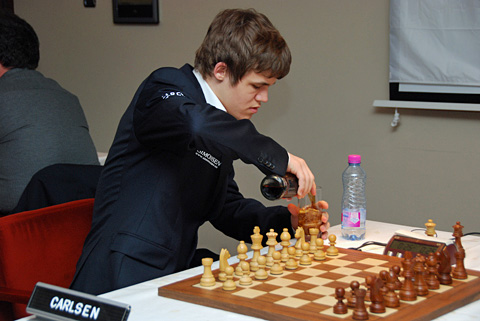 Magnus Carlsen Magnus Carlsen - Lenier Dom�nguez 19th Melody Amber Tounament (Rapid Competition), Round 9 Nice, 22 March 2010 Open Sicilian Game: Najdorf-Boleslavsky Defense (Opocensky Opening) 1.e4 c5 2.Nf3 d6 3.d4 cxd4 4.Nxd4 Nf6 5.Nc3 a6 6.Be2 e5 7.Nb3 Be7 8.0-0 0-0 9.Kh1
9...Nc6
10.f4 b5 11.Be3 Bb7
12.a4 Nb4!?
13.Qd2
13...d5 14.fxe5 Nxe4 15.Nxe4 dxe4 16.Nd4
16...Nd5 17.Nf5!?
17...Qc7 18.Bd4 e3!?
!""""""""# $t+ + Tl+% $+vW VoOo% $o+ + + +% $+o+mPn+ % $p+ B + +% $+ + O + % $ PpQb+pP% $R + +r+k% /(((((((() WHITE: Magnus Carlsen Position after 18...e4e3 19.Qe1
19...Bc5
20.Bxc5
20...Qxc5 21.Bd3!? Bc8
22.Nd6 Qd4?
!""""""""# $t+v+ Tl+% $+ + +oOo% $o+ N + +% $+o+mP + % $p+ W + +% $+ +bO + % $ Pp+ +pP% $R + Qr+k% /(((((((() WHITE: Magnus Carlsen Position after 22...Qc5d4 23.axb5!
23...Be6
24.bxa6 Qxe5 25.Qh4! f5 26.Nc4 Qf6
27.Qh3 f4 28.Qxh7+ Kf7 29.Qe4 Kg8 30.Ra5 Rfd8
!""""""""# $t+ T +l+% $+ + + O % $p+ +vW +% $R +m+ + % $ +n+qP +% $+ +bP + % $ Pp+ +pP% $+ + +r+k% /(((((((() WHITE: Magnus Carlsen Position after 30...Rf8d8 31.Nxe3!!
31...Nxe3 32.Rxf4 Nf5 33.Raxf5
33...Bxf5 34.Rxf5 Qh6 35.h3
35...Ra7 36.Qc4+ Kh8
37.Qc5 g6 38.Rf6 Rg7 39.Rf8+
39...Rxf8 40.Qxf8+ Kh7 41.Kh2
41...Qe3 42.Qd6 Qg5
43.b4 Re7 44.b5 Re5
!""""""""# $ + + + +% $+ + + +l% $p+ Q +o+% $+p+ T W % $ + + + +% $+ +b+ +p% $ +p+ +pK% $+ + + + % /(((((((() WHITE: Magnus Carlsen Position after 44...Re7e5 45.Qxg6+!!
45...Qxg6 46.Bxg6+ Kxg6 47.a7! 1-0
|
| Printer Friendly | Permalink | | Top |
| Jack Rabbit
|
Sat Mar-27-10 10:56 PM Response to Reply #2 |
| 5. Svidler - Grischuk, Blindfold Competition, Round 6 |
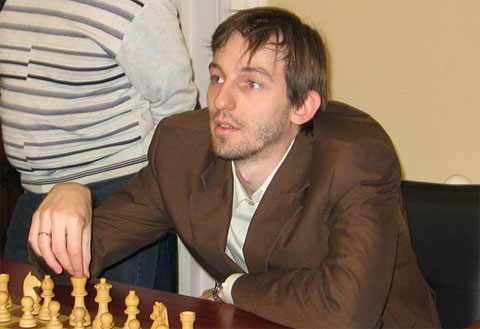 Alexander Grischuk Peter Svidler - Alexander Grischuk 19th Melody Amber Tournament (Blindfold Competition), Round 6 Nice, 19 March 2010 Semi-Slav Queen's Gambit: Meran Defense (Wade Variation) 1.d4 Nf6 2.c4 e6 3.Nf3 d5 4.Nc3 c6 5.e3 Nbd7 6.Bd3 dxc4 7.Bxc4 b5 8.Bd3 Bb7 9.e4 b4 10.Na4 c5 11.e5 Nd5 12.0-0 cxd4 13.Nxd4 Be7
14.Qh5
14...g6 15.Qe2!?
15...0-0
16.Bb5
16...a6
17.Nc6?
!""""""""# $t+ W Tl+% $+v+mVo+o% $o+n+o+o+% $+b+mP + % $nO + + +% $+ + + + % $pP +qPpP% $R B +rK % /(((((((() WHITE: Peter Svidler Position after 17.Nd4c6 17...axb5!!
18.Nxd8 Rfxd8 19.Qxb5 Ba6!
20.Qc6 Bd3
21.Re1 Rac8!
22.Qb7 Rc7 23.Qxc7 Nxc7
24.a3 Ra8 25.axb4
25...Bxb4
26.Rd1 Bb5 27.b3 Nd5
28.Bb2 Rb8 29.Bd4 Kg7 30.g3
30...g5 31.Rac1 !""""""""# $ T + + +% $+ +m+oLo% $ + +o+ +% $+v+mP O % $nV B + +% $+p+ + P % $ + + P P% $+ Rr+ K % /(((((((() WHITE: Peter Svidler Position after 31.Rac1 31...Be2! 0-1
|
| Printer Friendly | Permalink | | Top |
| Jack Rabbit
|
Sat Mar-27-10 10:58 PM Response to Reply #2 |
| 6. Kramnik - Ponomariov, Blindfold Competition, Round 5 |
|
Edited on Sat Mar-27-10 10:59 PM by Jack Rabbit
 Vladimir Kramnik Vladimir Kramnik - Ruslan Ponomariov 19th Melody Amber Tounament (Blindfold Competition), Round 5 Nice, 18 March 2010 West India Game: Tal-Indian Defense (Benko Gambit) (Modern Benoni) 1.d4 Nf6 2.c4 g6 3.f3 c5 4.d5 b5 5.cxb5 a6 6.e4 Bg7
7.e5
7...Ng8 8.f4 d6 9.Nf3 Nd7 10.Nc3
10...dxe5!?
11.fxe5
11...Nxe5 12.bxa6 Qa5!?
13.Nxe5 Bxe5 14.Bb5+
14...Kf8 15.Qf3 Kg7 16.0-0 Bd4+ 17.Be3
17...Nf6
18.d6 Bf5 19.a4!?
19...e5?
!""""""""# $t+ + + T% $+ + +oLo% $p+ P Mo+% $WbO Ov+ % $p+ V + +% $+ N Bq+ % $ P + +pP% $R + +rK % /(((((((() WHITE: Vladimir Kramnik Position after 19...e7e5 20.Ne2!
20...Qd8
21.Bxd4 cxd4 22.Qg3 Ng4
23.h3 Ne3 24.Qxe5+ f6
!""""""""# $t+ W + T% $+ + + Lo% $o+ O Oo+% $+v+ Qv+ % $p+ O + +% $+ + M +p% $ P +n+p+% $R + +rK % /(((((((() WHITE: Vladimir Kramnik Position after 24...f7f6 25.Qxd4! Nc2
26.Qc5 Nxa1 27.Rxa1 Qc8
28.b4 Bxh3 29.d7 Bxd7 30.Qe7+ Kh6 31.Bxd7 Qxa6
32.Nd4 Qd3 33.Qxf6 Rhf8 34.Qh4+ Kg7 35.Ne6+ 1-0
|
| Printer Friendly | Permalink | | Top |
| Jack Rabbit
|
Sat Mar-27-10 11:00 PM Response to Reply #2 |
| 7. Gashimov - Smeets, Rapid Competition, Round 8 |
 Vugar Gashimov Vugar Gashimov - Jan Smeets 19th Melody Amber Tounament (Rapid Competition), Round 8 Nice, 21 March 2010 Epine Dorsal: Horseman Defense (Janisch Opening) (Petroff Defense) 1.e4 e5 2.Nf3 Nf6 3.Nxe5 d6 4.Nf3 Nxe4 5.d4 d5 6.Bd3 Nc6 7.0-0 Be7 8.Re1 Bg4 9.c4 Nf6 10.Nc3
10...Nxd4
11.cxd5 Bxf3 12.gxf3 c5 13.d6
13...Qxd6 14.Nb5 Nxb5!?
15.Bxb5+
15...Kf8 16.Qe2 a6 17.Bf4 Qxf4?!
18.Qxe7+!
18...Kg8 19.Be8!?
19...Qg5+!
!""""""""# $t+ +v+lT% $+o+ QoOo% $o+ + M +% $+ O + W % $ + + + +% $+ + +p+ % $pP + P P% $R + R K % /(((((((() WHITE: Vugar Gashimov Position after 19...Qf4g5+ 20.Kh1!
20...Qh5 21.Re3
21...h6 22.Ba4 b5!
23.Bc2 c4
24.Rd1 Nh7 25.Rg1!?
25...Nf8!?
26.f4!
26...Ng6?
!""""""""# $t+ + +lT% $+ + QoO % $o+ + +mO% $+o+ + +w% $ +o+ P +% $+ + R + % $pPb+ P P% $+ + + Rk% /(((((((() WHITE: Vugar Gashimov Position after 26...Nf8g6 27.Qe4!
27...Rd8
28.f5 Nf8 29.Qe7 Rd7
!""""""""# $ + + MlT% $+ +tQoO % $o+ + + O% $+o+ +p+w% $ +o+ + +% $+ + R + % $pPb+ P P% $+ + + Rk% /(((((((() WHITE: Vugar Gashimov Position after 29...Rd8d7 30.Rxg7+!!
30...Kxg7 31.Rg3+ Kh7 32.f6+ Ng6 33.Qxd7 1-0
|
| Printer Friendly | Permalink | | Top |
| Jack Rabbit
|
Sat Mar-27-10 11:15 PM Response to Reply #1 |
| 8. Bundesliga, Germany, Rounds 12 & 13 |
| Printer Friendly | Permalink | | Top |
| Jack Rabbit
|
Sat Mar-27-10 11:30 PM Response to Reply #8 |
| 9. Potkin - Areshchenko, Katernberg, Round 12 |
|
Edited on Sun Mar-28-10 12:30 AM by Jack Rabbit
This game knocked Bremen out of a first place tie in Round 12.
 Vladimir Potkin Vladimir Potkin (M�lheim) - Alexander Areshchenko (Bremen) Bundesliga 0910, Round 12/Board 6 Katernberg, 20 March 2010 West India Game: Indian Queen's Gambit (Catalan Opening) (Gr�nfeld Defense) 1.d4 Nf6 2.c4 g6 3.g3 d5 4.cxd5 Nxd5 5.Bg2 Bg7 6.Nf3 Nb6
7.Nc3 Nc6 8.e3 0-0 9.0-0 Re8
10.Re1
10...a5 11.Qe2
11...e5
12.Nxe5 Nxe5 13.dxe5 Bxe5 14.e4 Bd7
15.f4 Bxc3 16.bxc3 Bc6 17.Bb2 Qd6!?
18.c4!?
!""""""""# $t+ +t+l+% $+oO +o+o% $ MvW +o+% $O + + + % $ +p+pP +% $+ + + P % $pB +q+bP% $R + R K % /(((((((() WHITE: Vladimir Potkin Position after 18.c3c4 18...Qc5+!
19.Kh1 Qxc4 20.Qe3?
20...f5 21.Rac1 Rxe4?
22.Bxe4 Qxe4+ 23.Qxe4 Bxe4+ !""""""""# $t+ + +l+% $+oO + +o% $ M + +o+% $O + +o+ % $ + +vP +% $+ + + P % $pB + + P% $+ R R +k% /(((((((() WHITE: Vladimir Potkin Position after 23...Bc6e4:Q
24.Kg1 Nd5 25.Be5!?
25...c6 26.a3 Kf7!
27.Kf2 Ke6 28.g4 Ra6 29.g5 Rb6 30.Rg1 Rb3 31.Rg3!
31...Rxg3 32.hxg3 Kd7 33.Ke2 b6 34.Kd2 c5 35.a4!?
!""""""""# $ + + + +% $+ +l+ +o% $ O + +o+% $O OmBoP % $p+ +vP +% $+ + + P % $ + K + +% $+ R + + % /(((((((() WHITE: Vladimir Potkin Position after 35.a3a4 35...Nb4
36.Rd1 Kc6 37.Kc3
37...Nd5+ 38.Kb2 b5 39.axb5+ Kxb5 40.Ka3!?
40...a4!?
41.Rd2 Nb4 42.Rh2
42...Nc2+ 43.Ka2 a3
!""""""""# $ + + + +% $+ + + +o% $ + + +o+% $+lO BoP % $ + +vP +% $O + + P % $k+m+ + R% $+ + + + % /(((((((() WHITE: Vladimir Potkin Position after 43...a4a3 44.Rxh7!
44...Bd5+ 45.Kb1 Nb4 46.Ba1
46...Be4+ 47.Kc1 Na2+ 48.Kd2 Kb4
49.Rh8 Bf3 50.Rg8 c4
51.Rb8+ Kc5?!
52.Bg7!
52...Bd5
53.Rd8?!
53...Be4!
54.Rc8+
54...Kb4 55.Rb8+ Kc5?
!""""""""# $ R + + +% $+ + + B % $ + + +o+% $+ L +oP % $ +o+vP +% $O + + P % $m+ K + +% $+ + + + % /(((((((() WHITE: Vladimir Potkin Position after 55...Kb4c5 56.Bf8+!
56...Kd5
57.Rb5+
57...Ke6 58.Bxa3 c3+ 59.Ke3 Kd7 60.Rb6 Bc6 61.Rb8 Bd5 62.Rf8 1-0
|
| Printer Friendly | Permalink | | Top |
| Jack Rabbit
|
Sat Mar-27-10 11:59 PM Response to Reply #8 |
| 10. Nikolic - Rabiega, Berlin, Round 12 |
|
Edited on Sun Mar-28-10 12:02 AM by Jack Rabbit
Solingen kept pace with Baden Baden during the weekend.
 Predrag Nikolic Predrag Nikolic (Solingen) - Robert Ragiega (K�nig Tegel) Bundesliga 0910, Round 12/Board 1 Berlin, 20 March 2010 Open Queen's Gambit: Royal Defense (Chigorin Defense) 1.d4 d5 2.c4 Nc6 3.Nc3 dxc4 4.d5 Ne5 5.f4
5...Nd7 6.e4 Nb6 7.a4 a5 8.Be3 e6 9.Nf3
9...Bb4 10.Bxb6 cxb6 11.Bxc4 Nf6 12.Bb5+!?
12...Bd7
13.dxe6 fxe6 14.Bd3!?
14...Qc7!
15.Qd2 Qc5 16.Ne5
16...0-0
17.Ke2
17...Be8 18.g4 Nd7 19.Nxd7 Bxd7 20.Rhf1!?
20...Rac8!
21.Rac1 Qe7 22.Qe3 !""""""""# $ +t+ Tl+% $+o+vW Oo% $ O +o+ +% $O + + + % $pV +pPp+% $+ NbQ + % $ P +k+ P% $+ R +r+ % /(((((((() WHITE: Predrag Nikolic Position after 22.Qd2e3 22...Bxc3!
23.Rxc3 Qb4!
24.Qd2 Qxa4 25.Ke3 e5 26.fxe5 Bxg4
27.Bc4+?
27...Kh8 28.Rxf8+ Rxf8 29.Qd6
29...Qe8!
30.e6 Rf3+ 31.Kd4 Rxc3?
!""""""""# $ + +wT L% $+o+ + Oo% $ O Qp+ +% $O + + + % $ +bKp+v+% $+ T + + % $ P + + P% $+ + + + % /(((((((() WHITE: Predrag Nikolic Position after 29...Rf3c3:R 32.Kxc3!
35...b5 33.Bd5 h6
34.e7! Kh7 35.Kd4 Bh5 36.e5 1-0
|
| Printer Friendly | Permalink | | Top |
| Jack Rabbit
|
Sun Mar-28-10 12:00 AM Response to Reply #8 |
| 11. Najer - Shirov, Emsdetten, Round 13 |
|
Meanwhile, in spite of hitting a speed bump in round 10, Baden Baden kept on rolling and is in excellent shape to win its 5th Bundeslinga title in a row.
 Alexei Shirov Evgeny Najer (Wattensheid) - Alexei Shirov (Baden Baden) Bundesliga 0910, Round 13/Board 1 Emsdetten, 21 March 2010 Spanish Grand Royal Game: Neo-Classical Defense 1.e4 e5 2.Nf3 Nc6 3.Bb5 a6 4.Ba4 Nf6 5.0-0 b5 6.Bb3 Bc5 7.a4 Rb8 8.c3 d6 9.d4
9...Bb6 10.a5 Ba7 11.Be3 Bg4 12.dxe5 Bxf3 13.Qxf3!?
13...Nxe5
14.Qe2 Bxe3 15.Qxe3 0-0 16.Nd2 Re8 17.f3!?
17...c5 18.Bc2 Qc7!
19.Rfd1
19...d5
20.Qf2
20...c4 21.exd5 Nxd5 22.Ne4 Nf4
23.Qc5 Qb7 24.Rd6 Ned3!?
25.Bxd3!
25...Nxd3 26.Qd5!?
!""""""""# $ T +t+l+% $W + +oOo% $o+ R + +% $Po+q+ + % $ +o+n+ +% $+ Pm+p+ % $ P + +pP% $R + + K % /(((((((() WHITE: Evgeny Najer Position after 26.Qc5d5 26...Qa7+!
27.Qd4 Qxd4+ 28.Rxd4 f5 29.Nd6 Re2
30.Nxf5?
!""""""""# $ T + +l+% $+ + + Oo% $o+ + + +% $Po+ +n+ % $ +oR + +% $+ Pm+p+ % $ P +t+pP% $R + + K % /(((((((() WHITE: Evgeny Najer Position after 30.Nd6f5:p 30...Rbe8!
31.h4
31...Rxb2 32.Rd7
32...Kf8 33.Rxg7
33...Re5 34.Rg5 h6?
35.f4?
!""""""""# $ + + L +% $+ + + + % $o+ + + O% $Po+ TnR % $ +o+ M P% $+ P + + % $ T + +p+% $R + + K % /(((((((() WHITE: Evgeny Najer Position after 35.f3f4 35...Nxf4!
36.Nxh6
36...Rxg5 37.hxg5 Rxg2+ 38.Kh1 Rxg5 39.Rf1 Rh5+ 40.Kg1 Rxh6 41.Rxf4+ Ke7 42.Kg2 Rg6+ 0-1
|
| Printer Friendly | Permalink | | Top |
| Jack Rabbit
|
Sun Mar-28-10 12:04 AM Response to Reply #1 |
| 12. Bonus Game: Keres - Smyslov, Candidates' Trmt, Z�rich, 1953 |
 Vasily Smyslov Paul Keres - Vasily Smyslov Candidates' Tournament, Round 24 Z�rich, 13 October 1953 Symmetrical English Game: Queen's Indian Defense 1.c4 Nf6 2.Nc3 e6 3.Nf3 c5 4.e3
4...Be7 5.b3
5...0-0
6.Bb2 b6 7.d4
7...cxd4 8.exd4 d5 9.Bd3 Nc6 10.0-0 Bb7
11.Rc1 Rc8 12.Re1!?
12...Nb4
13.Bf1 Ne4 14.a3
14...Nxc3 15.Rxc3 Nc6 16.Ne5
16...Nxe5 17.Rxe5!?
17...Bf6 18.Rh5 g6 19.Rch3?
!""""""""# $ +tW Tl+% $Ov+ +O+o% $ O +oVo+% $+ +o+ +r% $ +pP + +% $Pp+ + +r% $ B + OoO% $+ +q+bK % /(((((((() WHITE: Paul Keres Position after 19.Rc3h3 19...dxc4!!
20.Rxh7
20...c3! 21.Qc1 Qxd4
22.Qh6 Rfd8 23.Bc1 Bg7 24.Qg5 Qf6 25.Qg4
25...c2 26.Be2
26...Rd4!
27.f4 !""""""""# $ +t+ +l+% $Ov+ +oVr% $ O +oWo+% $+ + + + % $ + T Pq+% $Pp+ + +r% $ +o+b+pP% $+ B + K % /(((((((() WHITE: Paul Keres Position after 27.f2f4 27...Rd1+!!
28.Bxd1 Qd4+ 0-1
|
| Printer Friendly | Permalink | | Top |
| Jack Rabbit
|
Sun Mar-28-10 11:58 PM Response to Reply #1 |
| 13. Bonus Game: N. Kosintseva - Tairova, Russian Women's Championship, Moscow, 2007 |
|
Elena Tairova, a rising star in Russian women's chess, passed away March 16 after a long illness. She was 18 years old.
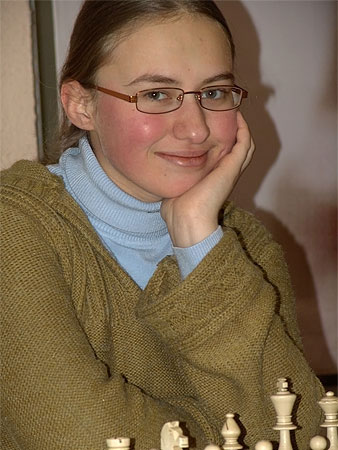 Elena Tairova 1991 - 2010 Nadezhda Kosintseva - Elena Tairova Russian National Championships (Women's Group), Round 2 Moscow, 19 Decenber 2007 Closed French Game: Nimzo-Winawer Defense 1.e4 e6 2.d4 d5 3.Nc3 Bb4 4.e5 c5 5.a3 Ba5
6.Bd2
6...Nc6 7.b4!?
7...Bc7
8.Nb5 Nxd4 9.Nxd4 cxd4
!""""""""# $t+vWl+mT% $OoV +oOo% $ + +o+ +% $+ +oP + % $ P O + +% $P + + + % $ +p+ PpP% $R +qKbNr% /(((((((() WHITE: Znosko-Borovsky Position after 9...cd4:N 10.f4 Ne7
11.Nf3 Bb6 12.Bd3 Bd7
13.0-0 Rc8 14.a4 a6 15.Kh1 Nf5 16.Qe2!
16...h5 17.Rfc1 h4 18.Be1
18...Rc3!?
!""""""""# $ + Wl+ T% $+o+v+oO % $oV +o+ +% $+ +oPm+ % $pP O P O% $+ Tb+n+ % $ +p+q+pP% $R R B +k% /(((((((() WHITE: Znosko-Borovsky Position after 18...Rc8c3 19.Ng5!?
19...Qe7!?
20.Bxc3 dxc3!?
21.Bxf5!
21...exf5 22.Qf3!?
22...h3!
23.Nxh3 Qxb4 24.Nf2 Qd4 25.Nd3!?
!""""""""# $ + +l+ T% $+o+v+oO % $oV + + +% $+ +oPo+ % $p+ W P +% $+ On+q+ % $ +p+ +pP% $R R + +k% /(((((((() WHITE: Znosko-Borovsky Position after 25.Nf2d3 25...Bxa4!
26.Rab1 a5!?
27.Qg3 0-0 28.Ra1
28...Rc8!?
29.Qh3 Bd7 30.Rf1
30...Rc6 31.Rae1?
31...Rh6 32.Qf3
32...Ba4 33.Re2 Bb5 34.Rd1
!""""""""# $ + + +l+% $+o+ +oO % $ V + + T% $Ov+oPo+ % $ + W P +% $+ On+q+ % $ +p+r+pP% $+ +r+ +k% /(((((((() WHITE: Znosko-Borovsky Position after 34.Rf1d1 34...Bxd3!
35.Qxd3
35...Qxd3
36.Rxd3 d4!
37.Re1 Bc5 38.Rb1
38...b6 39.Ra1 Kf8 40.g3 Ke7 41.Kg2
41...Rh8 42.h3
42...Ra8 43.Kf3 Ke6 44.Rdd1 Kd5 45.g4
45...fxg4+ 46.Kxg4 a4 47.Re1 b5
48.Kf3 Rh8 49.Rh1 a3 50.Rae1
50...b4
51.e6 fxe6 52.Re5+ Kc4 53.Ke4 a2 54.Rxe6 Rxh3!! 0-1
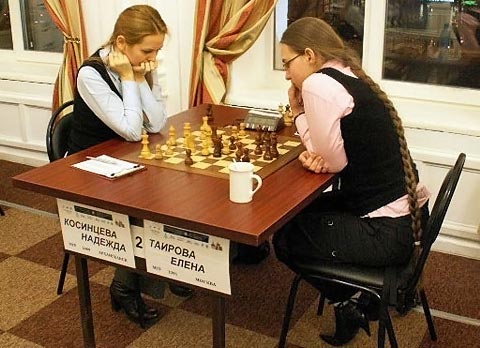 |
| Printer Friendly | Permalink | | Top |
| Jack Rabbit
|
Tue Mar-30-10 06:54 PM Response to Original message |
| 14. Update (Monday): MTel 2010 Canceled |
|
Edited on Tue Mar-30-10 06:55 PM by Jack Rabbit
The MTel Masters' Tournament will not be held in 2010 according to Bulgarian chess manager and organizer Silvio Danailov in an interview published today on the website Chessdom.com.
Danailov explained that the tournament sponsor is also putting up money for the world championship match on Sofia between Vishy Anand, the reigning champion, and Bulgarian grandmaster Veselin Topalov, the former FIDE titleholder, which begins April 23. The sponsor did not feel it could commit to two major chess events staged so close together. |
| Printer Friendly | Permalink | | Top |
| JonLP24
|
Tue Mar-30-10 07:18 PM Response to Original message |
| 15. RIP Smyslov |
|
Nice work with the chess threads JR. I don't contribute much but I do read them.
|
| Printer Friendly | Permalink | | Top |
| DU
AdBot (1000+ posts) |
Sat Jan 04th 2025, 08:40 PM Response to Original message |
| Advertisements [?] |
| Top |
| Home » Discuss » Topic Forums » Sports |
|
Powered by DCForum+ Version 1.1 Copyright 1997-2002 DCScripts.com
Software has been extensively modified by the DU administrators
Important Notices: By participating on this discussion board, visitors agree to abide by the rules outlined on our Rules page. Messages posted on the Democratic Underground Discussion Forums are the opinions of the individuals who post them, and do not necessarily represent the opinions of Democratic Underground, LLC.
Home | Discussion Forums | Journals | Store | Donate
About DU | Contact Us | Privacy Policy
Got a message for Democratic Underground? Click here to send us a message.
© 2001 - 2011 Democratic Underground, LLC